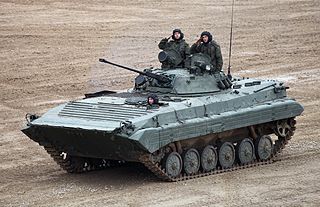
The BMP-2 is an amphibious infantry fighting vehicle introduced in the 1980s in the Soviet Union, following on from the BMP-1 of the 1960s.

The Combat Vehicle Reconnaissance (Tracked), abbreviated CVR(T), is a family of armoured fighting vehicles (AFVs) developed in the 1960s and is in service with the British Army and others throughout the world. They are small, highly mobile, air-transportable armoured vehicles, originally designed to replace the Alvis Saladin armoured car.

The FV101 Scorpion is a British armoured reconnaissance vehicle, and also a light tank. It was the lead vehicle and the fire support type in the Combat Vehicle Reconnaissance (Tracked), CVR(T), family of seven armoured vehicles. Manufactured by Alvis, it was introduced into service with the British Army in 1973 and was withdrawn in 1994. More than 3,000 were produced and used as a reconnaissance vehicle or a light tank.
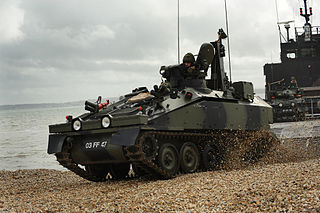
FV103 Spartan is a tracked armoured personnel carrier of the British Army. It was developed as the APC variant of the Combat Vehicle Reconnaissance (Tracked) family. The vehicle can carry up to seven personnel, including three crew members. Armed with a single machine gun, it is almost indistinguishable from the FV102 Striker in external appearance.
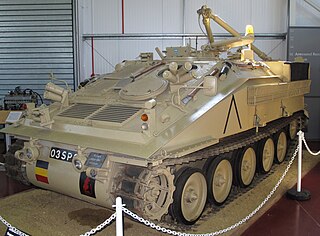
FV106 Samson was a British Army armoured recovery vehicle, one of the CVR(T) family. The main role of this vehicle was to recover the CVR(T) family of vehicles, but could also recover other light tracked vehicles such as the FV430 series.

The FV107 Scimitar is an armoured tracked military reconnaissance vehicle formerly used by the British Army, until it was retired from active service in April 2023. It was manufactured by Alvis in Coventry. It is very similar to the FV101 Scorpion, but mounts a high-velocity 30 mm L21 RARDEN cannon instead of a 76 mm gun. It was issued to Royal Armoured Corps armoured regiments in the reconnaissance role. Each regiment originally had a close reconnaissance squadron of five troops, each containing eight FV107 Scimitars. Each Main Battle Tank Regiment also employed eight Scimitars in the close reconnaissance role.

Sabre is a variation of the Combat Vehicle Reconnaissance (Tracked), featuring the turret from a wheeled Fox Armoured Reconnaissance Vehicle mounted on the hull of a tracked FV101 Scorpion.

The FV432 is the armoured personnel carrier variant in the British Army's FV430 series of armoured fighting vehicles. Since its introduction in the 1960s, it has been the most common variant, being used for transporting infantry on the battlefield. At its peak in the 1980s, almost 2,500 vehicles were in use.

The FV603 Saracen is a six-wheeled armoured personnel carrier designed and produced by Alvis since 1952. It has been used by a variety of operators around the world, and is still in use in secondary roles in some countries. The Saracen became a recognisable vehicle as a result of its part in the policing of Northern Ireland as well as for its role in the South African government's enforcement of apartheid.
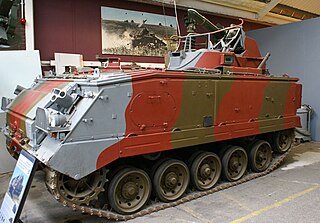
The FV438 Swingfire was an armoured anti-tank vehicle of the British Army.

The ASCOD armoured fighting vehicle family is the product of a cooperation agreement between Austrian Steyr-Daimler-Puch AG and Spanish General Dynamics Santa Bárbara Sistemas. The ASCOD family includes the LT 105, a light tank equipped with a 105 mm gun, a surface-to-air missile launcher, an anti-tank guided missile launcher, mortar carrier, R&R vehicle, command and control vehicle, ambulance, artillery observer, and the AIFV model. In Spanish service, the vehicle is called "Pizarro", while the Austrian version is called "Ulan".

The Land Rover Tangi is a type of armoured vehicle, based on the Land Rover chassis and used in policing in Northern Ireland. They were used by the Royal Ulster Constabulary (RUC) and are currently used by its replacement, the Police Service of Northern Ireland (PSNI). The vehicle was designed and built in house by the Royal Ulster Constabulary's own engineers.

The BTR-T was a Russian heavy APC, designed by the Design Bureau of Transport Machine-Building (Omsktransmash) state-run production association.
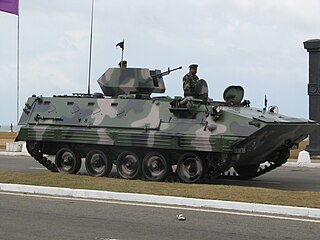
The Norinco Type 89 tracked armoured fighting vehicle is a Chinese armoured personnel carrier. It was developed from the earlier export market Type 85 AFV vehicle. It entered service in the late 1990s and was first shown publicly in 1999. There are approximately 1,000 in service. It has the industrial index of WZ534 and although it was mainly developed for the PLA, there is also an export version YW534.

The OT-62 TOPAS is a series of amphibious tracked armoured personnel carriers developed jointly by Polish People's Republic and Czechoslovakia (ČSSR). OT-62 stands for Obrněný Transportér vzor 62 – "armoured personnel carrier model 62". TOPAS stands for Transportér Obrněný Pásový – "tracked armoured personnel carrier".

The Fahd is a 4x4 Egyptian armored personnel carrier, designed to fit the requirements of the Egyptian Military. It replaced older APCs in Egyptian service such as the BTR-40, and the Walid. It has been used by the United Nations.
The Mechanised Infantry Vehicle (MIV) is the British Army's concept of an 8 × 8 wheeled vehicle. On 31 March 2018 the United Kingdom rejoined the Boxer programme in order to move to an assessment phase, which may see the Boxer selected.
The M577A4 Armored Treatment Vehicle (ATV) is a U.S. Army variant of the M577 Command Post Carrier made by United Defense which has been modified to function as an emergency medical treatment vehicle for personnel wounded or injured on the battlefield. It replaced the M577A3 Emergency Medical Treatment Vehicle in U.S. military service and is designed to operate in conjunction with the M113A4 Armored Medical Evacuation Vehicle (AMEV).
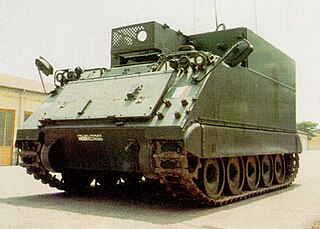
The M577 Command Post Carrier, also known as the M577 Command Post Vehicle or Armored Command Post Vehicle, is a variant of the M113 Armored Personnel Carrier that was developed and produced by the Food Machinery and Chemical Corporation (FMC) to function on the battlefield as a mobile command post i.e. a tactical operations centre, usually at the battalion level. In U.S. military service its official designation is Carrier, Command Post, Light Tracked M577.
The Norfolk Tank Museum is a collection of armoured fighting vehicles in Norfolk, East England. It is located just outside the village of Forncett St. Peter and 10 miles (16 km) south of the City of Norwich. The collection is made up of mostly British vehicles from the Cold War. The Museum contains around 30 military vehicles as well as a large collection of small arms. It includes the prototype Centurion AVRE 165, the only remaining Crossley-Kégresse 20-30 cwt half-track and a replica British First World War Mark IV that was built for The TV show Guy Martin's WWI Tank.


















